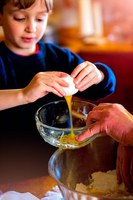Prairie Fare: Take an International Educational Tour in Your Kitchen
(Click an image below to view a high-resolution image that can be downloaded)
By Julie Garden-Robinson, Food and Nutrition Specialist
NDSU Extension
“Mom, do you know how to make spaetzle mac and cheese?” my son asked via text message.
Fortunately, I knew he was hungry for German egg noodles (spaetzle). One of our favorite local restaurants that specializes in the dish is closed temporarily.
“I think we need a special tool to make spaetzle,” I replied. “I will see what I can do.”
My son still thinks I can cook or bake anything. I need to maintain my “Mom cred.”
I learned a lot doing a Germans from Russia food project with the NDSU Library last year. However, we hadn’t made these free-form noodles at home.
The local specialty kitchen gadget store is closed for a while. I went online and found a tool for about $10.
This tool allows you to push dough droplets into boiling water through a sieve. The tool arrived within a couple of days. I could have improvised with a cheese grater and a spoon.
I think my kids inherited a lot of German genes from their dad. I am primarily of Scandinavian ancestry. However, I prefer German food. Don’t tell my relatives.
I made the cheese sauce and I supervised my son and daughter as they made the noodles, with lots of laughing in the process. It was a bit of a mess, but the time together reminded me of when they were kids.
Most people have spent more time at home in the last few weeks. Parents have become teachers for their children even more than usual. Kitchens can be a learning laboratory.
For example, reading recipes teaches language skills, including words in other languages.
I looked up the pronunciation of “spaeztle” online and found it pronounced with a long “a” and a short “e” sound. OK, I still don’t know the actual pronunciation.
I increased the size of the spaetzle recipe for my family by 50%. Downsizing and upsizing recipes teaches math skills.
Here’s some homework. If you want to halve a recipe calling for 3/4 cup of sugar, how much sugar would you use? How many tablespoons would that be?
You also can learn about science while exploring foods. For example, why do some recipes call for baking powder and others call for baking soda?
Both are leavening agents. Baking powder includes an acid and baking soda (sodium bicarbonate) to allow for carbon dioxide to be produced. Baking soda is used in recipes that include an acidic ingredient. If you are making chocolate chip cookies, the brown sugar includes molasses, which is acidic.
Here’s your homework answer: Half of 3/4 cup is 3/8 cup, which equals 6 tablespoons.
You also can explore cultural traditions through recipes. Do you have recipes from a distant grandparent, who may have immigrated from another country? In this challenging time we are experiencing in our present world, we can learn from our ancestors, who often faced great hardships in their lives. They made do with the ingredients that were available.
For example, my Norwegian relatives figured out how to make lefse from potatoes, flour, butter and cream. Germans made noodles from flour, eggs and milk. These recipes remain popular today.
I have a couple of resources to share with you this week. These resources will take you on a world trip without leaving your kitchen:
See https://tinyurl.com/NDGermansfromRussiaFood to view “Exploring North Dakota’s Foodways: Germans from Russia.”
See https://tinyurl.com/NDFoodCulture to view “North Dakota Food and Culture,” which includes recipes from 11 regions of the world. Most of the recipes were gathered from NDSU international graduate students and community members.
Here’s the spaetzle recipe, with high marks from my family members, along with some cook’s notes from me. White pepper is used in this recipe to prevent your noodles from having specks from black pepper, but the noodles will taste the same if you use black pepper.
In addition, some spaetzle recipes call for a pinch of nutmeg, which we didn’t add. While specialized tools are available, many people have success using a large-holed cheese grater and a spoon.
Spaetzle (German Egg Noodles)
1 c. all-purpose flour
1/8 tsp. white pepper
1/2 tsp. salt
2 eggs, beaten
1/4 c. milk
Begin heating about a gallon of water in a large pot. Meanwhile, mix dry ingredients in a medium-sized bowl. Beat eggs in separate bowl. Add beaten eggs and milk alternately while mixing thoroughly. The dough should be smooth and thick. Push the dough through a spaetzle tool directly into the boiling water. Alternately, use a large-holed cheese grater and a spoon to push the “dough droplets” into the hot water. Cook about one-third of the noodles at a time, and allow the noodles to cook until they float (about two minutes). Remove the noodles with a slotted spoon and drain well. Add more dough until all the dough is used. Top with butter or your desired sauce.
If desired, fry the finished noodles in butter and season as desired.
Makes four servings. Without toppings, each serving has 160 calories, 3 grams (g) fat, 7 g protein, 25 g carbohydrate, less than 1 g fiber and 340 milligrams sodium.
(Julie Garden-Robinson, Ph.D., R.D., L.R.D., is a North Dakota State University Extension food and nutrition specialist and professor in the Department of Health, Nutrition and Exercise Sciences. Follow her on Twitter @jgardenrobinson)
NDSU Agriculture Communication - April 23, 2020
| Source: | Julie Garden-Robinson, 701-231-7187, julie.garden-robinson@ndsu.edu |
|---|---|
| Editor: | Ellen Crawford, 701-231-5391, ellen.crawford@ndsu.edu |




